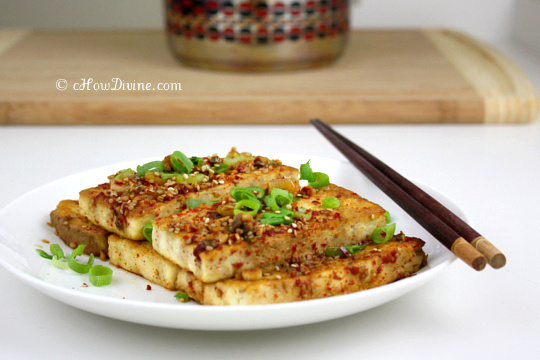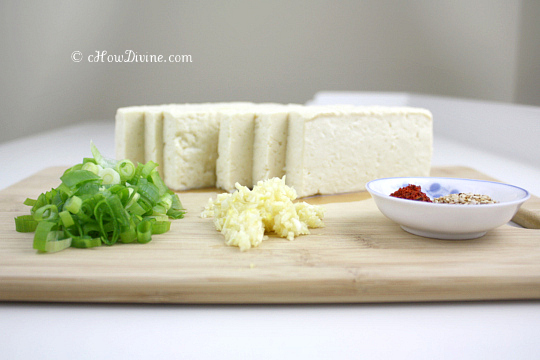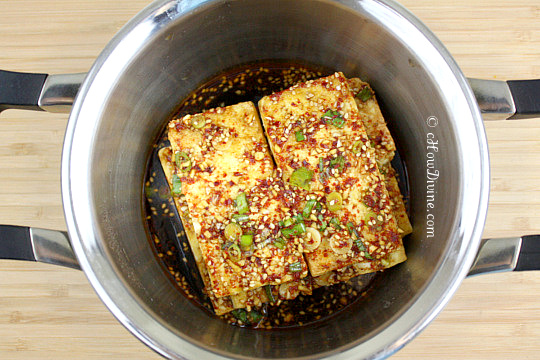I’ve been suffering from a meat and alcohol-induced walking coma since I got back from Missouri. The Missouri I experienced was sort of a meatopia with free-flowing wine. By no means am I a vegan nor do I abstain completely from imbibing. I eat meat and enjoy wine occasionally; but for the most part, I’m a vegan-leaning teetotaler. So needless to say, my body is in a bit of a shock.
So to give my body a break, I decided to make a bunch of vegan side dishes. Dubu jorim (soy-braised tofu) was on the top of my list, because my husband absolutely loves this dish. He really immersed himself in the meat-and-wine lifestyle while we were in Missouri; so he is due for a little vegan protein.
Dubu jorim is easy to make. And it’s delicious hot, warm, cold, or at room temperature. If I have any left over, I eat it the next day – cold, right out of the fridge – with some steamed rice, kimchi, and a side of gochujang for extra heat; I’m a hardcore Korean that way!
Dubu Jorim (Soy-Braised Tofu) Recipe
Ingredients
15 or 16 oz. tofu
3 TB tamari (gluten-free soy sauce)
2 TB water*
1 TB toasted sesame oil
1 clove garlic (finely minced)
2 scallions (chopped into thin rings)
1 1/2 tsp toasted sesame seeds + more for garnish/topping
1 1/2 tsp gohcugaru
canola oil
Note: Anchovy-dashima stock can be used in place of water for a non-vegan version of this dish.
- Combine tamari, water, toasted sesame oil, garlic, half of the chopped scallion, and gochugaru. Set it aside.
- Slice the tofu into thick (about 1/2 inch) pieces. Preheat a pan on medium-high heat. Once heated, add enough canola oil to coat the bottom of the pan. Add the sliced tofu to the pan and sear the tofu on both sides until golden brown.
- Place the seared tofu in a pot or a pan with a lid. Evenly pour all of the sauce from step one over the seared tofu. If you are using a smaller pot like I did, do it in layers; place a layer of tofu, add a drizzle of the sauce, place another layer, add some more sauce, and so on.
- Cover the pot and let it come to a boil. Lower the heat and let it simmer for 15-20 minutes.
- Remove from heat. Arrange tofu on a plate. Pour any remaining sauce in the pot over the tofu. Top with remaining half of the chopped scallions and sesame seeds. Serve with steamed rice and some kimchi.




This looks wonderful…and great idea to take a break after the wine and meats! I might have to try this dish this week!
Please do, Dawn! It was a lovely break from all marbled (albeit, tasty!) meats we’ve been consuming :-).
I was in the same boat, had most of the ingredients so I gave this a shot. As excellent as it looked!
So glad you enjoyed it Bryan! Thanks for letting me know how it turned out!
This sounds and looks delicious! Love tofu as much as I love eggs (which is a whole lot)! I’ll have to try this soon. What kind of tofu do you use? Is it hard/firm tofu?
Fern, I use firm tofu. And I sear it to make sure the tofu maintains its shape (and also for texture) throughout the cooking process as it tends to crumble sometimes. The sauce is really tasty. Try drizzling some on your rice. Let me know how it turns out!
Thanks! I will try it and let you know!
I’ve also nominated you for the Liebster Award, details here: http://tofoodwithluv.blogspot.com/2011/12/eggs-cooked-in-tomato-sauce.html
Thank you so much Fern! That is so sweet of you. I will take it as encouragement to keep cooking! 🙂
Made this tonight for a last minute dinner and it was absolutely fantastic. Easy as pie, and tasty as can be. You may mention it in other recipes, but I find it essential to press all tofu in kitchen towels, ridding it of liquid, before attempting to pan fry or sear it. Fresh out of the package it contains so much moisture that can get in the way of allowing the heat to properly brown the tofu.
Also, the kimchi is key!
Hey Nick, thanks for coming by the site! I’m glad you enjoyed the tofu. And I’m always happy to meet a person who loves kimchi!
As far as pressing the tofu, I don’t know of many Korean cooks who press the tofu to rid it of excess water – unless it will serve as part of a filling (e.g. Korean dumplings). I just pat it dry and lay it on a dry paper towel until I’m ready to cook. I’m all for less work! 🙂 Tho for other Asian cuisines – like Thai – or for baking, I do press it.